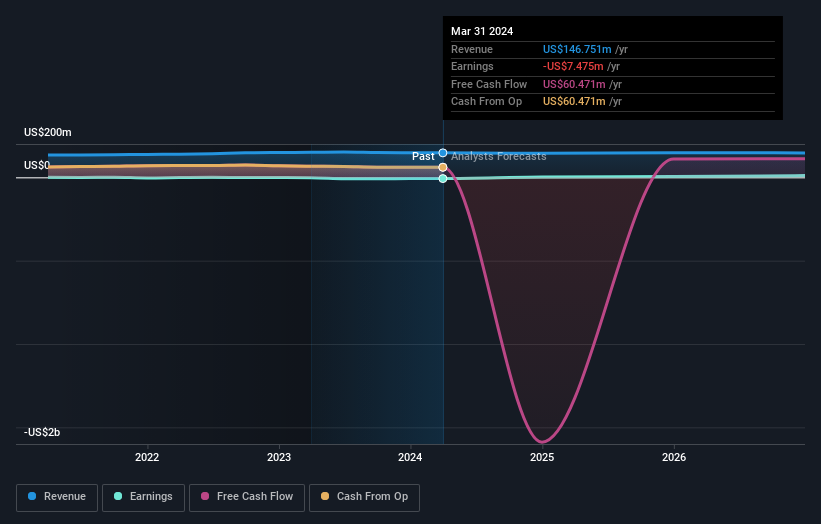Gladstone Commercial Corporation's (NASDAQ:GOOD) largest shareholders are retail investors with 54% ownership, institutions own 44%
Key Insights
Significant control over Gladstone Commercial by retail investors implies that the general public has more power to influence management and governance-related decisions
The top 25 shareholders own 39% of the company
Every investor in Gladstone Commercial Corporation (NASDAQ:GOOD) should be aware of the most powerful shareholder groups. We can see that retail investors own the lion's share in the company with 54% ownership. That is, the group stands to benefit the most if the stock rises (or lose the most if there is a downturn).
And institutions on the other hand have a 44% ownership in the company. Large companies usually have institutions as shareholders, and we usually see insiders owning shares in smaller companies.
Let's take a closer look to see what the different types of shareholders can tell us about Gladstone Commercial.
Check out our latest analysis for Gladstone Commercial
What Does The Institutional Ownership Tell Us About Gladstone Commercial?
Many institutions measure their performance against an index that approximates the local market. So they usually pay more attention to companies that are included in major indices.
We can see that Gladstone Commercial does have institutional investors; and they hold a good portion of the company's stock. This implies the analysts working for those institutions have looked at the stock and they like it. But just like anyone else, they could be wrong. If multiple institutions change their view on a stock at the same time, you could see the share price drop fast. It's therefore worth looking at Gladstone Commercial's earnings history below. Of course, the future is what really matters.
Gladstone Commercial is not owned by hedge funds. Our data shows that The Vanguard Group, Inc. is the largest shareholder with 10% of shares outstanding. BlackRock, Inc. is the second largest shareholder owning 7.8% of common stock, and Renaissance Technologies LLC holds about 3.4% of the company stock. In addition, we found that David Gladstone, the CEO has 1.2% of the shares allocated to their name.
Our studies suggest that the top 25 shareholders collectively control less than half of the company's shares, meaning that the company's shares are widely disseminated and there is no dominant shareholder.
While it makes sense to study institutional ownership data for a company, it also makes sense to study analyst sentiments to know which way the wind is blowing. There are a reasonable number of analysts covering the stock, so it might be useful to find out their aggregate view on the future.
Insider Ownership Of Gladstone Commercial
While the precise definition of an insider can be subjective, almost everyone considers board members to be insiders. Management ultimately answers to the board. However, it is not uncommon for managers to be executive board members, especially if they are a founder or the CEO.
I generally consider insider ownership to be a good thing. However, on some occasions it makes it more difficult for other shareholders to hold the board accountable for decisions.
Our most recent data indicates that insiders own some shares in Gladstone Commercial Corporation. As individuals, the insiders collectively own US$8.7m worth of the US$584m company. This shows at least some alignment. You can click here to see if those insiders have been buying or selling.
General Public Ownership
The general public -- including retail investors -- own 54% of Gladstone Commercial. This level of ownership gives investors from the wider public some power to sway key policy decisions such as board composition, executive compensation, and the dividend payout ratio.
Next Steps:
It's always worth thinking about the different groups who own shares in a company. But to understand Gladstone Commercial better, we need to consider many other factors. To that end, you should be aware of the 1 warning sign we've spotted with Gladstone Commercial .
If you would prefer discover what analysts are predicting in terms of future growth, do not miss this free report on analyst forecasts.
NB: Figures in this article are calculated using data from the last twelve months, which refer to the 12-month period ending on the last date of the month the financial statement is dated. This may not be consistent with full year annual report figures.
Have feedback on this article? Concerned about the content? Get in touch with us directly. Alternatively, email editorial-team (at) simplywallst.com.
This article by Simply Wall St is general in nature. We provide commentary based on historical data and analyst forecasts only using an unbiased methodology and our articles are not intended to be financial advice. It does not constitute a recommendation to buy or sell any stock, and does not take account of your objectives, or your financial situation. We aim to bring you long-term focused analysis driven by fundamental data. Note that our analysis may not factor in the latest price-sensitive company announcements or qualitative material. Simply Wall St has no position in any stocks mentioned.

 Yahoo Finance
Yahoo Finance 

